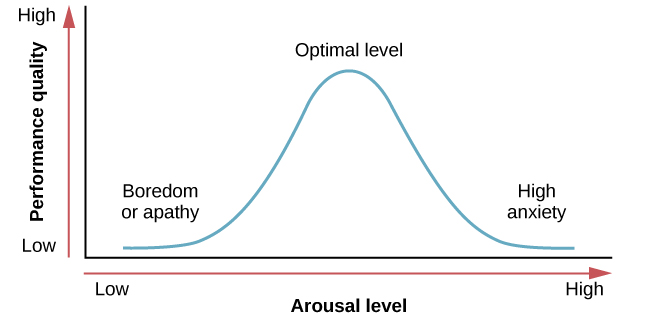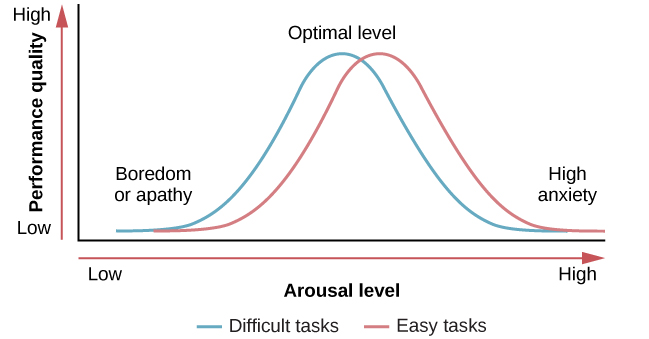Chapter 13. Motivation
The Optimal Arousal Model
Jessica Motherwell McFarlane
Approximate reading time: 3 minutes
Optimal Arousal Model builds on what we know about motivation. It says that we all have a “just right” level of alertness and energy that helps us do our best (Figure MO.10). If we’re not alert enough, we get bored and look for something to wake us up. If we’re too alert, or stressed, we try to find ways to relax (Berlyne, 1960). You’ve probably felt this during your time at school. Think about the end of the spring semester when everything seems to pile up. You might be stressed, trying to finish all your work. Then, summer comes, and you relax. But after a while, you start to feel bored. By the time Fall rolls around, maybe you are actually ready to get back to school. That’s the Optimal Arousal Model in action.

So, what’s this perfect level of alertness? Researchers have found that it is usually somewhere in the middle between really relaxed and really stressed (Yerkes & Dodson, 1908). Think about how you feel when you’re taking an exam. If you’re too relaxed, you might not do well because you don’t care enough. But if you’re too nervous, you might freeze up and not do well either. It’s like a softball team that’s so sure they’ll win, they don’t get pumped up for the game and end up losing to a team that’s not as good.
But it’s not always as simple as finding a middle ground. Researchers Robert Yerkes and John Dodson found that the best level of alertness depends on how hard the task is (Figure MO.11). They say that for easy tasks, it’s better to be more alert. But for hard tasks, it’s better to be less alert. This relationship is known as Yerkes-Dodson law, which holds that a simple task is performed best when arousal levels are relatively high and complex tasks are best performed when arousal levels are lower.

Figure 10.7 as found in Psychology 2e by OpenStax is licensed under a CC BY 4.0 License.
Image Attributions
Figure MO.10. Figure 10.6 as found in Psychology 2e by OpenStax is licensed under a CC BY 4.0 License.
Figure MO.11. Figure 10.7 as found in Psychology 2e by OpenStax is licensed under a CC BY 4.0 License.
To calculate this time, we used a reading speed of 150 words per minute and then added extra time to account for images and videos. This is just to give you a rough idea of the length of the chapter section. How long it will take you to engage with this chapter will vary greatly depending on all sorts of things (the complexity of the content, your ability to focus, etc).

